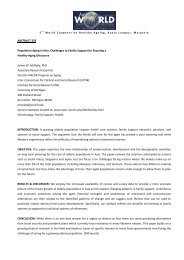The Pseudodementia Dilemma - 1st World Congress on Healthy ...
The Pseudodementia Dilemma - 1st World Congress on Healthy ...
The Pseudodementia Dilemma - 1st World Congress on Healthy ...
You also want an ePaper? Increase the reach of your titles
YUMPU automatically turns print PDFs into web optimized ePapers that Google loves.
Organised by:<br />
Co-Sp<strong>on</strong>sored:<br />
Malaysian <strong>Healthy</strong> Ageing Society
<str<strong>on</strong>g>The</str<strong>on</strong>g> <str<strong>on</strong>g>Pseudodementia</str<strong>on</strong>g> <str<strong>on</strong>g>Dilemma</str<strong>on</strong>g><br />
Dr. Prem Kumar Chandrasekaran<br />
C<strong>on</strong>sultant Neuropsychiatrist<br />
Penang Adventist Hospital
C<strong>on</strong>tent<br />
• <str<strong>on</strong>g>Pseudodementia</str<strong>on</strong>g> – what is it?<br />
• Types<br />
• Evoluti<strong>on</strong> of the term<br />
• Current thoughts<br />
• Differential diagnosis & approach
Introducti<strong>on</strong><br />
• <str<strong>on</strong>g>Pseudodementia</str<strong>on</strong>g> a popular clinical c<strong>on</strong>cept<br />
• Refers to a group of disorders:<br />
1. Depressive pseudodementia<br />
2. Ganser’s syndrome<br />
3. Hysterical pseudodementia<br />
4. Simulated dementia<br />
• Sachdev et al (1990) validated the term by<br />
dem<strong>on</strong>strating l<strong>on</strong>gitudinally no diagnostic<br />
change (except 1) in cases of pseudodementia<br />
over a period of more than a decade
Depressive pseudodementia (DPD)<br />
• Some patients with depressi<strong>on</strong> do not exhibit<br />
hallmarks symptoms of depressi<strong>on</strong> - some S/S<br />
like psychomotor retardati<strong>on</strong>, anhed<strong>on</strong>ia,<br />
labored thinking, slipshod behavior, failing to<br />
register events, faulty orientati<strong>on</strong> and loss of<br />
recent memory should alert clinician to<br />
possibility of this category of pseudodementia<br />
• Kiloh (1961) described the above set of<br />
symptoms with additi<strong>on</strong>ally self-neglect and<br />
loss of weight<br />
• Post (1965) added those symptoms to<br />
observati<strong>on</strong>s of tremulous elderly patients<br />
with shuffling gait
DPD (c<strong>on</strong>’t)<br />
• Folstein and McHugh (1978) claimed both<br />
dementia and depressi<strong>on</strong> interact together<br />
and the term ‘pseudodementia’ a misnomer<br />
as cognitive deficits resolve when the<br />
depressi<strong>on</strong> resolves - suggested the term<br />
‘dementia syndrome of depressi<strong>on</strong>’<br />
• Could depressi<strong>on</strong> then be a reacti<strong>on</strong> to<br />
cognitive impairment in dementia? - Reifler<br />
et al (1982) felt that was so but <strong>on</strong>ly in mild<br />
and early cases of dementia
DPD (c<strong>on</strong>’t)<br />
• Jacoby and Levy observed larger ventricles in elderly<br />
depressives (1980) and decreased brain absorpti<strong>on</strong><br />
density (1983) as compared to c<strong>on</strong>trols – thus, ageing<br />
processes affecting the brain, i.e. cerebral neur<strong>on</strong>al<br />
loss and neurochemical c<strong>on</strong>comitants of depressi<strong>on</strong><br />
lead to cognitive failure<br />
• View strengthened by Abas et al (1990) of 70% of 20<br />
elderly depressives having cognitive impairment and<br />
up<strong>on</strong> recovery from depressi<strong>on</strong>, a third were still<br />
cognitively compromised - in line with thoughts of<br />
depressi<strong>on</strong> being a harbinger of dementia as elderly<br />
depressives were at increased risk of developing<br />
dementia (Post, 1962), as well as figures from Reding et<br />
al (1985) when more than half of 28 depressed and n<strong>on</strong>demented<br />
patients became demented 3 years later
DPD (c<strong>on</strong>’t)<br />
• Saez-F<strong>on</strong>seca et al (2007) found 71.4%of their<br />
182 patients suffering from DPD had c<strong>on</strong>vert<br />
into dementia at follow-ups as compared to<br />
<strong>on</strong>ly 18.2% in the cognitively intact group -<br />
c<strong>on</strong>cluded that reversible cognitive impairment<br />
in late-life moderate to severe depressi<strong>on</strong><br />
appeared to be a str<strong>on</strong>g predictor of dementia<br />
• Korczyn & Halperin (2009) rati<strong>on</strong>alized that<br />
since depressi<strong>on</strong> and dementia are both<br />
comm<strong>on</strong> in old age and frequently occur<br />
together, white matter changes both in<br />
Alzheimer’s disease (AD) and in depressi<strong>on</strong> were<br />
thought to reflect vascular changes, hence the<br />
c<strong>on</strong>cept ‘vascular depressi<strong>on</strong>’
DPD (c<strong>on</strong>’t)<br />
• However, c<strong>on</strong>sidering a marked increase in<br />
phosphorylated tau protein in CSF being<br />
indicative of AD, Blennow et al (1995) suggested<br />
that it serves as a positive biochemical marker to<br />
discriminate AD from DPD, as well as from normal<br />
ageing and Parkins<strong>on</strong>’s disease<br />
• Shinske et al (2008) felt it important to<br />
distinguish dementia from DPD because cogniti<strong>on</strong><br />
and memory disorder in DPD patients are<br />
treatable – they described a case of senile<br />
depressi<strong>on</strong> with the above symptoms and<br />
diagnosis by SPECT and PET findings of low blood<br />
flow and low metabolism in her fr<strong>on</strong>tal lobe,<br />
which normalised with improvement of<br />
depressive mood after antidepressant therapy
D/D Dementia and DPD (Small et al, 1981)<br />
Characteristics Dementia DPD<br />
History<br />
Precise Onset Unusual Usual<br />
Durati<strong>on</strong> of symptoms L<strong>on</strong>g Short<br />
Rapid symptom<br />
progressi<strong>on</strong><br />
Complaints of cognitive<br />
loss<br />
Descripti<strong>on</strong> of cognitive<br />
loss<br />
Family awareness of<br />
dysfuncti<strong>on</strong> and<br />
severity<br />
Unusual<br />
Variable (minimized in<br />
later stages)<br />
Vague<br />
Variable (usual in later<br />
stages)<br />
Usual<br />
Emphasised<br />
Detailed<br />
Usual<br />
Loss of social skills Late Early<br />
Psychopathology history Uncomm<strong>on</strong> Comm<strong>on</strong>
D/D Dementia and DPD (Small et al, 1981)<br />
Characteristics Dementia DPD<br />
Examinati<strong>on</strong><br />
Memory loss for recent vs.<br />
remote events<br />
Specific memory loss (‘patchy’<br />
deficits)<br />
Greater<br />
Uncomm<strong>on</strong><br />
About equal<br />
Comm<strong>on</strong><br />
Attenti<strong>on</strong> and c<strong>on</strong>centrati<strong>on</strong> Often poor Often good<br />
‘D<strong>on</strong>’t know’ answers Uncomm<strong>on</strong> Comm<strong>on</strong><br />
‘Near miss’ answers<br />
Performance <strong>on</strong> tasks of similar<br />
difficulty<br />
Emoti<strong>on</strong>al reacti<strong>on</strong> to<br />
symptoms<br />
Variable (comm<strong>on</strong> in later<br />
stages)<br />
C<strong>on</strong>sistent<br />
Variable (unc<strong>on</strong>cerned/shallow<br />
in later stages)<br />
Uncomm<strong>on</strong><br />
Variable<br />
Great distress<br />
Affect Labile, blunted or depressed Depressed<br />
Efforts in task performance Great Small<br />
Efforts to cope with dysfuncti<strong>on</strong> Maximal<br />
Minimal
Rx of DPD<br />
• Primary focus is to treat with<br />
antidepressants<br />
• Treatment of depressi<strong>on</strong> improved MMSE<br />
scores with a rise to normal scores 2<br />
years later in the ‘depressed/demented’<br />
group (Rabins et al, 1984)<br />
• Post (1965) and Burgeois et al (1970)<br />
found ECT to be especially effective in<br />
this group
Ganser’s syndrome<br />
• 1 st described by Ganser in 1897<br />
• Frequently, attenti<strong>on</strong> is <strong>on</strong> classic symptom<br />
of ‘vorbeireden’ or approximate answers or<br />
answering past the point, which Scott (1965)<br />
described as Ganser’s symptom and which is<br />
comm<strong>on</strong>er than the syndrome itself<br />
• However, this has led to other features<br />
being overlooked, i.e. prominent<br />
hallucinatory experiences (?pseudo),<br />
hysterical stigmata and fluctuating<br />
disturbance in c<strong>on</strong>sciousness
Ganser’s syndrome<br />
• Resoluti<strong>on</strong> is abrupt with complete and<br />
sometimes, residual amnesia (‘hysterical<br />
twilight state’) for the brief durati<strong>on</strong> of the<br />
illness, which Ganser (1898) himself believed was<br />
central to the presentati<strong>on</strong> and that approximate<br />
answers al<strong>on</strong>e is not enough to make a diagnosis,<br />
as many later papers that relied <strong>on</strong> that single<br />
symptom found it to lack specificity when use<br />
al<strong>on</strong>e<br />
• Mentor, Nissl, even believed it to be a<br />
manisfestati<strong>on</strong> of ‘catat<strong>on</strong>ic negativism’ and 1<br />
of Ganser’s 3 patients did in fact have catat<strong>on</strong>ic<br />
posturing as a feature
Ganser’s syndrome<br />
• <str<strong>on</strong>g>The</str<strong>on</strong>g> apparent dementia that accompanies approximate<br />
answers is usually incomplete, inc<strong>on</strong>sistent and selfc<strong>on</strong>tradictory<br />
• Patients are able to adapt to demands of daily life which<br />
those with organic dementia cannot<br />
• Motor behavior ranges from dazed stupor to histri<strong>on</strong>ic<br />
outbursts of excitement; mood ranges from apathetic<br />
indifference to anxious bewilderment<br />
• Whitlock (1967) called it the ‘buff<strong>on</strong>ery syndrome of<br />
schizophrenia’ from the associated c<strong>on</strong>fabulati<strong>on</strong> and<br />
childish, playful attitude. However, this betrays knowledge<br />
of the purpose of questi<strong>on</strong>s put forward and by the close<br />
approximati<strong>on</strong>, the correct answers may be available to the<br />
patient to an extent, although the answers seem absurd<br />
• Patients with this c<strong>on</strong>diti<strong>on</strong> exercise full deliberati<strong>on</strong> and an<br />
apparent serious intent<br />
• McGrath and McKenna (1965) felt the approximate answers<br />
were a ‘compromise’ stating “I am insane, yet sane”
Ganser’s syndrome<br />
• Can occur during the course of a depressive<br />
illness, head injury, early dementia, alcoholism<br />
and other toxic states and purely as a resp<strong>on</strong>se to<br />
emoti<strong>on</strong>al trauma<br />
• Organic and psychogenic factors operate together<br />
here<br />
• C<strong>on</strong>cept of gain led to the term ‘pris<strong>on</strong> psychosis’<br />
and although malingering can be suspected,<br />
noteworthy to menti<strong>on</strong> that patients do not<br />
provide sp<strong>on</strong>taneous absurd remarks; merely<br />
answers to questi<strong>on</strong>s they were asked
Ganser’s syndrome<br />
• In modern psychiatry, difficulty in interpreting much of this<br />
literature is the nebulous criteria used to define the<br />
syndrome<br />
• Enoch & Trethowan (1979) proposed a set of 4 criteria –<br />
approximate answers, clouding of c<strong>on</strong>sciousness, visual<br />
and auditory hallucinati<strong>on</strong>s and somatic c<strong>on</strong>versi<strong>on</strong><br />
symptoms<br />
• DSM-3 preserved the ‘repressi<strong>on</strong>’ of the syndrome’s<br />
‘hysteric’ character, enlisting it am<strong>on</strong>g factitious disorders<br />
together with Munchausen syndrome but the<br />
‘hysteric/dissociative’ character was later recognized by<br />
the newer diagnostic systems<br />
• Change in c<strong>on</strong>sciousness, as well as c<strong>on</strong>versi<strong>on</strong> symptoms,<br />
proof that this is a hysterical syndrome and not simple<br />
malingering<br />
• Thus, grouped under dissociative disorders in the DSM-4 (and<br />
-TR) and under other dissociative (c<strong>on</strong>versi<strong>on</strong>) disorders in<br />
ICD-10
Hysterical pseudodementia<br />
• C<strong>on</strong>versi<strong>on</strong> pseudodementia in older people<br />
caused by catastrophic reacti<strong>on</strong> to cumulative<br />
loss in later life in individuals with predisposing<br />
borderline and narcissistic traits (Hepple, 2004)<br />
• Mechanisms of hysterical dissociati<strong>on</strong> may<br />
operate to some degree in pseudodementias<br />
• Likewise, covert affective disorders may<br />
c<strong>on</strong>tribute to hysterical pseudodementia<br />
• Also occurs in those with compromised<br />
intelligence<br />
• Syndrome is more comm<strong>on</strong> in women from higher<br />
socio-ec<strong>on</strong>omic background with past psychiatric<br />
histories dominated by depressive symptoms
Hysterical pseudodementia<br />
• Core features - apparent cognitive<br />
impairment, regressi<strong>on</strong> and increasing<br />
physical dependency<br />
• Other symptoms - classical sensory loss,<br />
paralysis and ‘belle indifferance’ of<br />
c<strong>on</strong>versi<strong>on</strong><br />
• <str<strong>on</strong>g>The</str<strong>on</strong>g>re can be fatuous cheerfulness or<br />
sullen apathy and in severe cases,<br />
hysterical puerilism, infantilism and<br />
amnesia
Hysterical pseudodementia<br />
• Treatment using psychotherapeutic<br />
approaches may limit the progressi<strong>on</strong> of<br />
the syndrome if recognised at an early<br />
stage<br />
• Role of abreacti<strong>on</strong> and sleep deprivati<strong>on</strong><br />
was described by Patrick and Hommels<br />
(1990), who c<strong>on</strong>versely found that<br />
c<strong>on</strong>fusi<strong>on</strong> was exacerbated with those<br />
modalities in patients having organic<br />
dementia
Simulated dementia<br />
• Memory loss appears to be an isolated main<br />
symptom<br />
• <str<strong>on</strong>g>The</str<strong>on</strong>g>re could also be mutism and lack of<br />
cooperati<strong>on</strong><br />
• Anders<strong>on</strong> et al (1989) failed to get 18 psychology<br />
students to c<strong>on</strong>vincingly feign dementia – with<br />
repeated efforts, fatigue set in and they<br />
experienced a ‘pull <strong>on</strong> reality’<br />
• Hunt (1973) used the MMPI to distinguish<br />
malingerers from subjects with organic dementia<br />
as the series of questi<strong>on</strong>s were designed to weed<br />
out inc<strong>on</strong>sistencies<br />
• Kraupl-Taylor (1966) observed the malingerer got<br />
anxious and upset when slips pointed out
Simulated dementia – D/D<br />
• Point in differentiating those simulating<br />
dementia - they appeared to be more<br />
‘superficial’ than patients with Ganser’s<br />
syndrome<br />
• Increase in c<strong>on</strong>scious malingering and the<br />
course of the disorder is l<strong>on</strong>ger and<br />
relapsing<br />
• Absence of melancholia present in DPD
D/D from Functi<strong>on</strong>al disorders<br />
• Sometimes, functi<strong>on</strong>al disorders have dementialike<br />
symptoms and in hypomania, distractibility<br />
and random answers can mimic disorientati<strong>on</strong><br />
and failing memory; playfulness could lead to<br />
false replies<br />
• Carney (1983) observed manic overactivity can be<br />
mistaken for agitati<strong>on</strong><br />
• In schizophrenia, poverty of ideas, emoti<strong>on</strong>al<br />
blunting and an unkempt state may suggest<br />
dementia<br />
• Misleading the clinical picture is presence of late<br />
paraphrenia (Roth, 1981) and dem<strong>on</strong>strati<strong>on</strong> of<br />
the presence of mild cognitive disorder and<br />
enlargement of ventricles (Naquib and Levy,<br />
1987)
C<strong>on</strong>clusi<strong>on</strong>s<br />
• <str<strong>on</strong>g>Pseudodementia</str<strong>on</strong>g> is a very real entity of<br />
disorders<br />
• Importance in recognising DPD as it is<br />
treatable<br />
• Clinicians needs to be aware of impact of<br />
hysterical c<strong>on</strong>versi<strong>on</strong> in pseudementias<br />
• Differentiating simulated dementia may<br />
identify malingerers
Thank You<br />
Main source:<br />
Lishman WA: Organic Psychiatry - <str<strong>on</strong>g>The</str<strong>on</strong>g> Psychological C<strong>on</strong>sequences of<br />
Cerebral Disorder (3 rd Editi<strong>on</strong>). Blackwell Science, 1998















